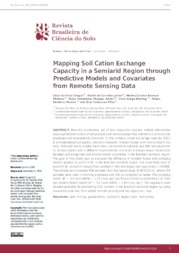Mapping soil cation exchange capacity in a semiarid region through predictive models and covariates from remote sensing data.
Mapping soil cation exchange capacity in a semiarid region through predictive models and covariates from remote sensing data.
Autoria: CHAGAS, C. da S.; CARVALHO JUNIOR, W. de; PINHEIRO, H. S. K.; XAVIER, P. A. M.; BHERING, S. B.; PEREIRA, N. R.; CALDERANO FILHO, B.
Resumo: Planning sustainable use of land resources requires reliable information about spatial distribution of soil physical and chemical properties related to environmental processes and ecosystemic functions. In this context, cation exchange capacity (CEC) is a fundamental soil quality indicator; however, it takes money and time to obtain this data. Although many studies have been conducted to spatially quantify soil properties on various scales and in different environments, not much is known about interactions between soil properties and environmental covariates in the Brazilian semiarid region. The goal of this study was to evaluate the efficiency of random forest and cokriging models applied to predict CEC in the Brazilian semiarid region. The covariates used to predict CEC consist of images from Landsat 5 TM and a legacy soil map (scale 1:10,000). The sample set comprises 499 samples from the topsoil layer (0.00-0.20 m), where 375 samples were used in training processes and 124 as validation samples. The cokriging model (R2= 0.57 and RMSE = 7.22 cmol c kg-1) performed better in predicting CEC than the random forest model (R2= 0.47 and RMSE = 7.89 cmol c kg-1). The approach used showed potential for estimating CEC content in the Brazilian semiarid region by using covariates obtained from orbital remote sensing and the legacy soil map.
Ano de publicação: 2018
Tipo de publicação: Artigo de periódico
Unidade: Embrapa Solos
Palavras-chave: Geoestatística, Landsat 5, Levantamento, Mineração de dados, Reconhecimento do Solo, Soil surveys, Solo
Observações
1 - Por padrão são exibidas publicações dos últimos 20 anos. Para encontrar publicações mais antigas, configure o filtro ano de publicação, colocando o ano a partir do qual você deseja encontrar publicações. O filtro está na coluna da esquerda na busca acima.
2 - Para ler algumas publicações da Embrapa (apenas as que estão em formato ePub), é necessário ter, no celular ou computador, um desses softwares gratuitos. Sistemas Android: Google Play Livros; IOS: iBooks; Windows e Linux: software Calibre.
Acesse outras publicações
Acesse a Base de Dados da Pesquisa Agropecuária (BDPA) para consultar o acervo completo das bibliotecas da Embrapa.

